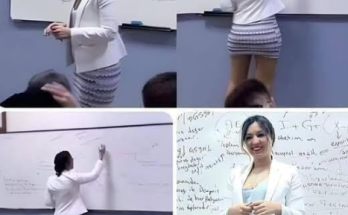
30 Optical Illusions That’ll Make You Look Twice
In a world where our eyes are constantly processing thousands of images every minute, sometimes what we see isn’t what’s really there. Optical illusions have fascinated scientists, artists, and ordinary people for centuries. They remind us that reality is not always as straightforward as it appears — and that the human brain loves to be fooled. From clever photography tricks to artistic creations and naturally occurring illusions, here are 30 incredible optical illusions that will make you stop, stare, and look twice.
1. The Floating Rock
At first glance, it looks like a boulder hovering above the ground. A closer look reveals a perfectly placed shadow beneath it — just a trick of perspective and lighting.
2. The Endless Staircase
Inspired by M.C. Escher’s famous “Relativity,” this illusion depicts stairs that seem to go up and down forever, defying the laws of gravity and geometry.
3. Faces or Flowers?
A classic dual-image illusion — what looks like a bouquet of white flowers suddenly transforms into a group of human faces when viewed differently.
4. The Moving Dots
A simple grid of black and white dots seems to dance when you move your eyes across it. It’s caused by the way your brain processes contrast and motion.
5. The Disappearing Wheel
Spin a striped wheel and watch as it appears to slow, reverse, and stop — even though it’s spinning continuously. This is known as the wagon-wheel illusion.
6. The Camouflage Cat
A tabby cat perfectly matches the pattern of a woven blanket. It takes a few seconds to notice its eyes peeking out — a real-life example of natural optical deception.
7. The Bending Pencil
Stick a pencil halfway into a glass of water, and it looks broken. This is light refraction in action, bending rays as they move from air to water.
8. The Tilted House
A tourist attraction in Oregon lets you walk through a house built on a slope. The angles are so skewed that water seems to flow uphill and people appear to lean impossibly.
9. Two Faces, One Vase
The Rubin vase illusion shows how perception can flip: you either see two profiles looking at each other, or a single ornate vase — but not both at once.
10. The Hidden Animal
A forest photo full of leaves and branches hides a perfectly camouflaged owl. It’s a reminder that our brains often miss details when overwhelmed by textures.
11. The Impossible Triangle
The Penrose triangle looks like a solid 3D object — until you realize such a shape can’t exist in real space. It’s pure geometric trickery.
12. The Floating Person
A person stands on one leg and leans forward, appearing to levitate. The secret: a hidden platform and careful camera placement.
13. The Color-Changing Dress
Remember the viral debate — blue and black or white and gold? Lighting and context fooled millions of people, proving that perception is deeply personal.
14. The Melting Road
A long, shimmering highway on a hot day looks flooded. It’s not water — it’s a mirage caused by light refracting off heated air near the ground.
15. The Coffee Cup Shadow
A coffee cup’s handle casts a shadow that looks like a heart. It’s all about angle and timing — and perfect for an Instagram moment.
16. The Expanding Circles
Concentric circles appear to pulse or grow when you move your gaze. This illusion plays with the brain’s motion detectors and contrast sensitivity.
17. The “Hole in the Hand” Trick
Look through a rolled-up piece of paper next to your open palm — your brain fuses the images, creating the illusion of a hole through your hand.
18. The Two-Faced Portrait
In some paintings, a young woman’s profile turns into an elderly face when flipped. Artists have used this technique for centuries to hide dual meanings.
19. The Stretching Bridge
A photo of a bridge taken from the right angle makes it look like it’s bending upward into the clouds — a simple perspective illusion that feels surreal.
20. The Mirror Maze
Walk through mirrored hallways and suddenly lose track of where reflections end and reality begins. It’s a real-life mind maze that confuses even seasoned illusion lovers.
21. The Vanishing Train Tracks
Parallel lines seem to converge in the distance, even though they don’t. This classic perspective illusion has inspired photographers for decades.
22. The Rotating Snakes
Static images that appear to move — the result of color contrast and subtle gradients tricking your motion perception.
23. The Human Wall
A group of people dressed in patterned outfits blend perfectly into a graffiti-covered wall. It’s part camouflage, part creative art.
24. The Melting Building
A Paris museum façade was transformed with warped panels, making it appear as though the entire building was melting under the sun.
25. The Hidden Faces in Nature
Look closely at tree trunks, mountains, or clouds — our brains are wired to find faces everywhere, a phenomenon called pareidolia.
26. The Floating Tap
A sculpture of a water tap with a continuous flow seems suspended in midair. The secret? The clear tube hidden inside the stream supports it.
27. The Giant Baby Hand
A close-up photo of a baby’s hand next to a distant adult makes it look enormous — a reminder that depth perception depends entirely on context.
28. The Shadow Sculpture
An abstract pile of metal casts a shadow that forms a perfect human figure when light hits it from the right angle — a triumph of creative design.
29. The Twisted Lines
Parallel lines appear curved when surrounded by angled patterns — the “Café Wall” illusion that proves straight lines can look warped under contrast.
30. The Infinite Tunnel
Two mirrors placed opposite each other create an endless tunnel of reflections. It’s mesmerizing — a simple setup with a powerful effect.
Why Optical Illusions Matter
Beyond entertainment, illusions reveal how our visual systems interpret the world. The brain constantly takes shortcuts — filling in gaps, adjusting for light, and guessing what it expects to see. When those shortcuts fail, illusions emerge. They teach us humility: that even our most trusted sense, sight, can be unreliable.
Scientists use illusions to study perception, artists use them to spark wonder, and photographers use them to tell stories. Ultimately, they remind us that beauty often lies in mystery — and that sometimes, seeing isn’t believing.

